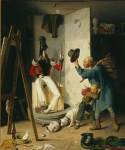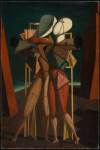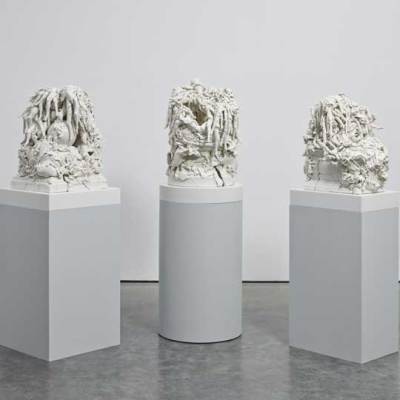My back hurts when I visit exhibitions these days. It must be a sign of getting old. Usually I find it intensely frustrating as physical discomfort distracts me from my visual and intellectual enjoyment. But not in the Fitzwilliam Museum’s new show ‘Silent Partners’. In a narrative about the progress of the mannequin in human history ‘from function to fetish’ it added that extra dimension to be reminded of the physical experience of my body in the space.
‘Silent Partners’ looks at how the uncanny presence of the artist’s mannequin has changed from the 16th to 21st centuries. The ‘lay figure’ has developed from being a necessary but embarrassing tool used by almost every artist but never acknowledged (and never intentionally evident in a painting) to a conscious element of modern art, intended to comment on the nature of human life. Along the way, 19th-century artists grappled with criticism of stiff mannequin poses evident in their works, before embracing the use of the wooden model as a silent presence in the room. A particularly striking group of paintings shows mannequins counterposed with classical busts, in a conversation between antiquity and modernity, the eternal nature of, but changing attitude to, the human body.
This is an enjoyably interdisciplinary show. From the introductory section on the emergence of the mannequin in western art, the role of anatomical models in studying the human body is emphasised. An exquisite Auzoux papier-mâché model takes its place alongside Old Master drawings, polychrome saints, manufacturing patterns and wooden models. Likewise, the 19th-century paintings that began to acknowledge the mannequin within the studio are juxtaposed with contemporaneous French treatment for hysteria, in which hypnosis essentially turned women into living mannequins arranged for medical photography.
Inevitably it is the female body that is at the centre of the narrative as the site of fascination and fetish. As the introductory text puts it so beautifully, mannequins ‘manipulated the viewer’s emotions, just as they did the jointed figure’. Women’s own relationship with their silent counterparts is considered in the context of the emergence of luxury dolls and fashion mannequins. But it is the Surrealists, Giorgio de Chirico, Oskar Kokoschka, and finally the Chapman Brothers that bring home the uncanny nature of the objects in the show. Their figures are re-contextualised, reduced to simple shapes or to exaggerated sexual features, and even mutilated. They become actively repellent versions of the body, rather than simply unnerving.
A ‘spine’ of different mannequins runs down the centre of the two main rooms, connecting up what is at times a slightly overwhelming display, dense with text. I found myself increasingly aware of other visitors in the space, seen through glass cases and around frozen torsos. In the quiet exhibition space, the relationship of silently absorbing audience and silently watching exhibits brought home the narrow gap between real and imagined figures. We all construct and manipulate our bodies.
‘Silent Partners’ is at the Fitzwilliam Museum, Cambridge, until 25 January 2015.
Related Articles
12 Days: Highlights of 2014 (Maggie Gray)
Small Wonders: Musée Bourdelle (Amélie Simier)








